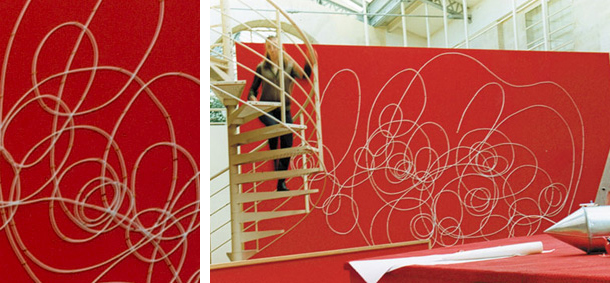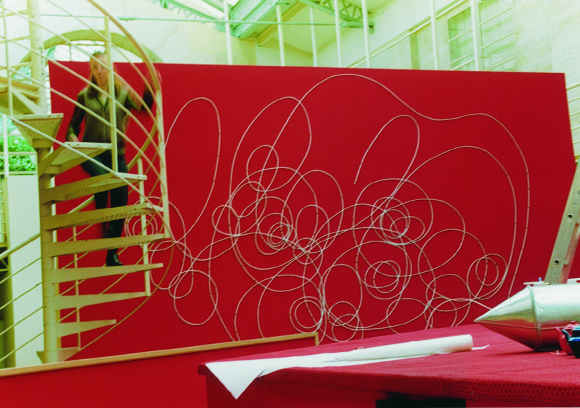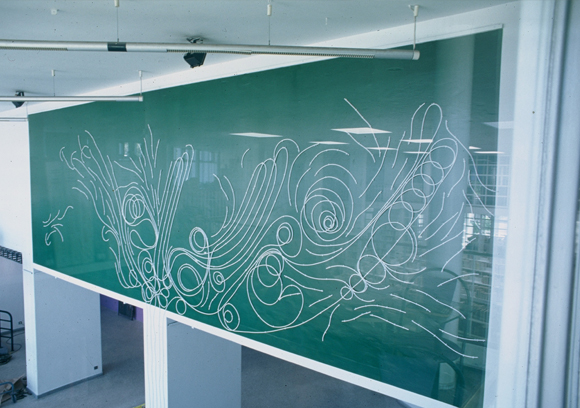| |
|
|
04.
| Connections tribute to Jackson Pollock |
| |


1999, coaxial antenna cable, staples, painting, size may vary.
Exhibition view from L'objet désorienté, Musée des Arts décoratifs, 1999, Paris.
Courtesy of the artist and Ceysson & Benetiere, Paris.
Ed. of 5 + 1 A.P.
'' The sculpture is an invitation to explore the semantic possibilities of the term “Connections”, which can designate a type of relation between things
or the binding element in the composition of a substance; in other words, it’s what creates a link,
similarly to the lines and letters that are bound together in Arab calligraphy. ''
Studio Fatmi, July 2017

Connections tribute to Jackson Pollock
Exhibition view from L'objet désorienté, Musée des Arts décoratifs, 1999, Paris.
Courtesy of the artist.

Connections tribute to Jackson Pollock
Courtesy of the artist.
|
|
|
|
|
|
Les Liaisons est une sculpture réalisée à l'aide d'agrafes à têtes rondes et d'une section de plus de 500 mètres de câble coaxial à gaine blanche disposée en entrelacs se superposant sur une surface verticale rectangulaire peinte en rouge, reprenant les couleurs du drapeau marocain. La sculpture a été présentée en 1999 au Musée des Arts Décoratifs de Paris. La France célèbre alors l'année du Maroc et multiplie les échanges afin de promouvoir la création contemporaine. Il s'agit pour Mounir Fatmi d'une de ses premières résidences artistiques en France. C'est également l'époque de ses premières œuvres recourant aux câbles coaxiaux - matériau utilisé jusqu'à la fin du 20e siècle pour relier une antenne à un téléviseur et transmettre des images.
Le projet artistique de Mounir Fatmi s'inspire de la série des Arabesques de Jackson Pollock peintes autour de 1948, et dont le titre permet de faire le lien entre l'art américain des années 40 et 50 et l'art arabo-musulman. Les Liaisons explorent ainsi le domaine des interactions culturelles en faisant se rencontrer les techniques de l'art contemporain telles que le all over et le dripping, et les techniques artisanales de la calligraphie arabe avec ses lignes sinueuses et idéales. "Hommage", l'œuvre se veut affirmation d'une référence et témoignage de considération. Elle constitue une marque de respect à l'irrespect, conçu comme un affranchissement par rapport aux règles de composition picturale, aux conventions artistiques ou aux stéréotypes sociaux... Dans un contexte d'échanges culturels, l'œuvre évoque également les rapports entre la création artistique et le mouvement et le déplacement spatial ou géographique.
La sculpture invite à explorer les possibilités sémantiques du terme "Liaisons" qui peut désigner un type de relation entre les choses ou l'agent de liaison entrant dans la composition d'une matière, autrement dit ce qui fait le lien, à la manière des traits déliés qui s'unissent aux lettres dans la calligraphie arabe. L'œuvre affirme un lien étroit et intime entre des univers artistiques malgré la distance ou la différence, ce qui les réunit étant le geste créateur et libre. Les Liaisons permettent d'observer les effets d'une rencontre et de la mise en relation d'éléments divers. Le recouvrement et l'effacement, ont ici pour effet d'annuler le statut initial de l'objet : le drapeau supposé est transformé en toile vierge.
La sculpture Les Liaisons met en évidence la nécessité du déplacement pour la création artistique. Le déplacement constitue l'origine d'une prise de conscience de ses propres acquis culturels et introduit la possibilité d'en modifier le contenu, d'y ajouter des influences, d'unir les références pour produire de la nouveauté. Les câbles coaxiaux deviennent ainsi un matériau plastique essentiel des œuvres de Mounir Fatmi. Ils expriment le lien entre la "petite histoire", la biographie de l'artiste, et la "grande histoire", le cours historique. Ils symbolisent les relations entre l'univers artistique de Mounir Fatmi et celui d'autres artistes et insistent sur la circulation de l'information et les connexions établies.
Studio Fatmi, Juillet 2017.
|
|
Connections is a sculpture made with rounded tacks and over 500 meters of white coaxial cable, intertwined and piled up on a vertical surface painted red, reproducing the colors of the Moroccan flag. The sculpture was presented in 1999 at the Musée des Arts Décoratifs in Paris. France was celebrating the year of Morocco and set up numerous exchanges in order to promote contemporary creation. This was the occasion for one of Mounir Fatmi’s first artistic residences in France. It was also around that time he created his first pieces using coaxial cable – a material used until the end of the 20th century to connect an antenna to a television set and transmit images.
Mounir Fatmi’s artistic project was inspired by Jackson Pollock’s series Arabesques, painted around 1948, whose title created a bridge between American art of the 1940s and 1950s and Arab-Muslim art. Connections explores the field of cultural interactions by reuniting contemporary art techniques, such as all over and dripping, and the artisanal techniques of Arab calligraphy, with their ideal and sinuous lines. “Tribute”, as this piece is meant to be the affirmation of a reference and a testimony for esteem. It constitutes a sign of respect for disrespect, seen as a form of emancipation from the rules of pictorial composition, artistic conventions and social stereotypes… In a context of cultural exchanges, the piece also evokes the relation between artistic creation and spatial or geographic movement or displacement.
The sculpture is an invitation to explore the semantic possibilities of the term “Connections”, which can designate a type of relation between things or the binding element in the composition of a substance; in other words, it’s what creates a link, similarly to the lines and letters that are bound together in Arab calligraphy. The artwork states a close and intimate link between artistic universes despite distance or differences, reuniting them as a free and creative gesture. Connections lets us observe the effects of an encounter and the creation of a link between various elements. Covering up and erasing have the effect of canceling the initial status of the object: the supposed flag is transformed into a blank canvass.
The Connections sculpture highlights the necessity of movement for artistic creation. Movement is the starting point for realizing one’s own cultural baggage and introduces the possibility to modify its contents, add influences and bring together references to create something new. In this way, coaxial cables become an essential plastic material in Mounir Fatmi’s work. They express the link between “personal history”, the artist’s biography, and “general history”, the course of international events. They symbolize the relations between Mounir Fatmi’s artistic universe and that of other artists and emphasize the importance of circulation of information and establishing connections.
Studio Fatmi, July 2017. |
|
|
|